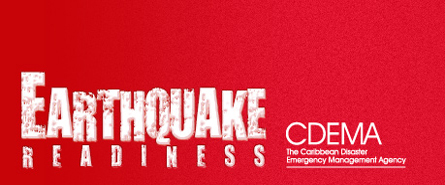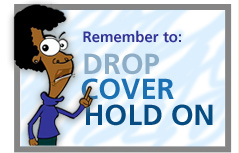|
Checklists should be prepared summarising what each person should do before, during, and after an earthquake. The following pages provide samples that can be adapted to individual situations. For example, students' and teachers' checklists can be made into wall posters for the classroom.
Checklists
Principal
- Before:
- Set up a chain of command, and define staff roles and responsibilities (first aid, roll call, search and rescue, etc.)
- Establish earthquake and evacuation drills for all staff and students
- In large schools, decentralise first aid equipment, student lists, and instructions for turning off gas, electricity, water, etc.
- Be aware of your area's lines of communication, disaster planning, emergency channels, etc.
- Obtain battery-operated emergency am/fmradio and learn local emergency radio frequencies
- Designate an outdoor evacuation assembly area
- Ensure staff knowledge of industrial first aid.
- After:
- Stay calm: your attitude will act as a role model for everyone
- Ensure that all power, fuel, and water mains have been shut off
- Account for all staff and students
- In a major quake, await instructions from emergency officials over battery-operated or car radio
- Oversee conservation and distribution of uncontaminated water, as well as preparation of emergency facilities
- Allow dismissal of students only when it is safe to travel and a designated adult comes for him/her; keep accurate records of students released.
back to top
Teacher
- Before:
- Hold classroom discussions
- Practice drills
- Hold hazard hunts, correct hazards where possible
- Appoint two student monitors in case you are injured
- Prepare class lists and identification tags with name, address, phone number, age and medic alert information.
- During:
- Issue the "EARTHQUAKE" order at first sign of tremor
- Drop, Cover and Hold until the shaking stops
- Talk calmly to reassure students
- Assess the situation to determine whether or not to evacuate
- Respond as required
- Review evacuation procedures.
- To Evacuation:
- Instruct students to evacuate lead class to the designated assembly area
- Be prepared to choose alternative escape route in case of fire or exit blockage
- Take class list, i.d. tags, and first aid kit
- Administer first aid, if necessary
- Do not re-enter the building unless instructed by the principal
- Write i.d. information on foreheads of primary and injured children, if tags not available
- Reassure students
- Remind students that parents may be delayed in calling for them
- Encourage students to talk about their fears and anxieties.
Student
- Before:
- Learn what to expect and what to do during an earthquake
- Identify hazards in the classroom, school and home
- Participate in earthquake drills
- Know the name and address of your guardian, if designated by your parent(s).
- During:
- Follow teacher's cues.
- "Drop, Cover and Hold"
- DROP to the ground
- TAKE COVER under a sturdy table or other piece of furniture. Kneel and bend your head close to your knees.
- HOLD ON to the table leg or desk (a few inches above the ground to void pinching fingers). Cover your eyes with your other hand. If your "shelter" moves, move with it.
- COUNT to 60
- If out of the classroom, take cover in the "CRASH" position; count to 60; join the nearest class when shaking stops.
- After:
- Follow all instructions from teacher or designated monitor
- If the teacher orders an evacuation,
- wear shoes
- put on identification tag
- comfort and reassure other students
- DO NOT use an elevator
- DO NOT re-enter school without permission
- DO NOT go home without permission; be aware that your parent/guardian may be delayed in coming for you
- Talk about what has happened.
back to top
Parent
- Before:
- Be aware of school's earthquake policy and procedures
- Provide school with the name of an alternative guardian.
- After:
- Do not phone the school -- they may be trying to reach you or emergency response services
- Listen to the designated radio station am/fm for instructions and information
- When you are told it is safe to travel, go to the school to collect your child
- If you are unable to reach the school, contact the designated guardian to collect your child -- your child will NOT be released otherwise.
Maintenance Staff
- Before:
- Coordinate with principal to identify and eliminate, if possible, potential interior and exterior earthquake hazards; inspect chemical storage areas regularly
- Establish earthquake drill with responsibilities for shutting off power, fuel, and water mains clearly described
- Make sure you have a crescent or pipe wrench near the gas and water valves and in your emergency supplies
- Establish procedure for setting up emergency toilets, uncontaminated water supplies, and first aid centres
- Know location and use of fire- fighting equipment.
- After:
- Immediately carry out pre-arranged duties (e.g., shutting off gas main, fire fighting, water supply control, etc.)
- Report to principal and assist in search and rescue, if necessary
- With supervisor, determine safety of building for possible re-entry
- Assist in setting up emergency facilities, if necessary.
Bus Driver
- Before:
- Be acquainted with school earthquake procedures
- During:
- Stop bus away from power lines, overpasses, bridges, etc.; pull into side road or driveway, if possible
- Stay in the bus
- With students, assume "crash" position between seats or in aisles and count aloud to 60.
- After:
- If roads are passable, proceed with caution
- If bus is immobilised in an unsafe position, evacuate to an open area because of danger of aftershocks
- Administer first aid, if necessary
- When safe to do so, proceed with students on foot to nearest undamaged shelter
- Contact supervisor, school, police, or other emergency authority by any means possible without leaving students unattended
- Stay with the students until help arrives or until instructed to move.
back to top
|













